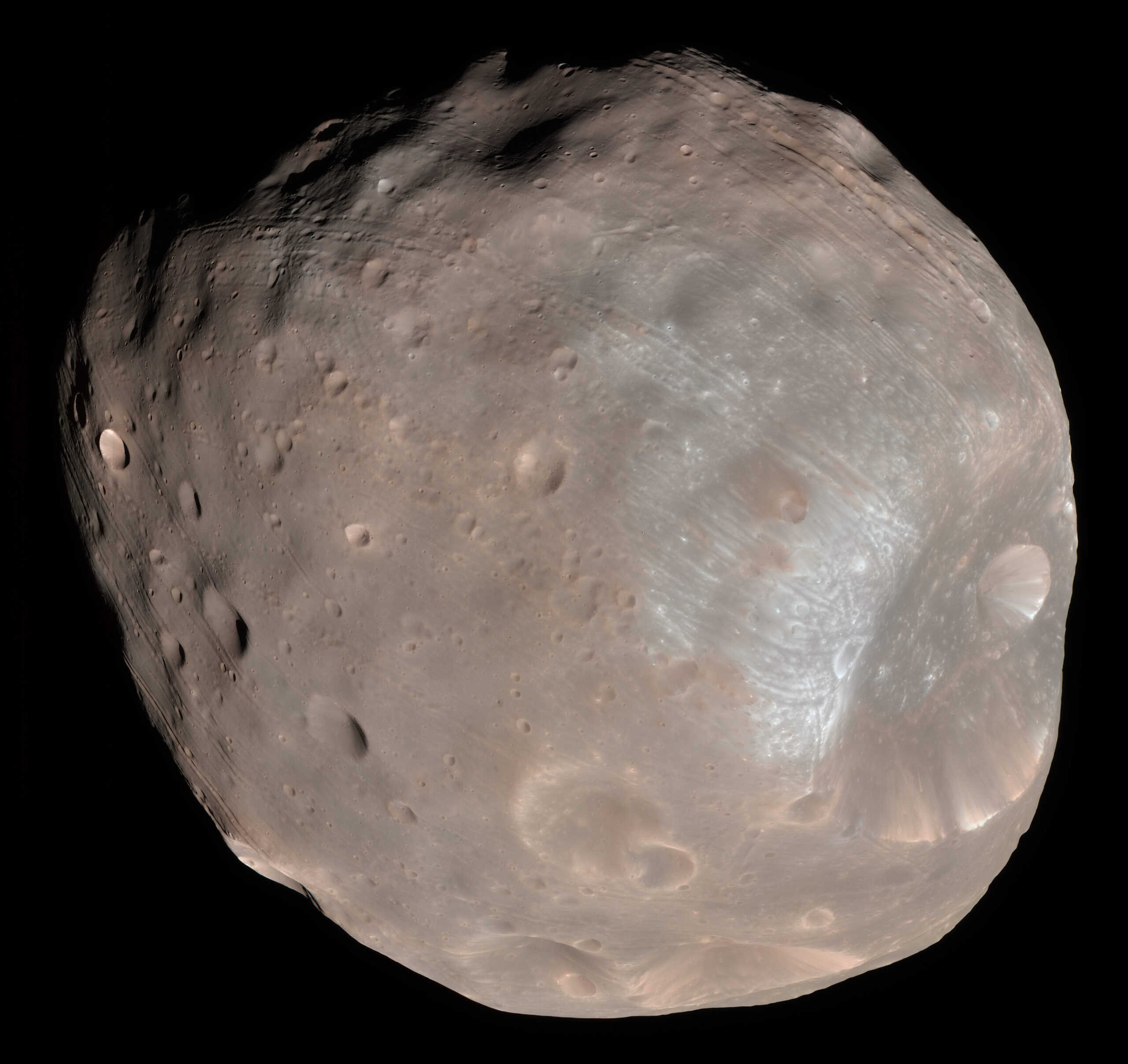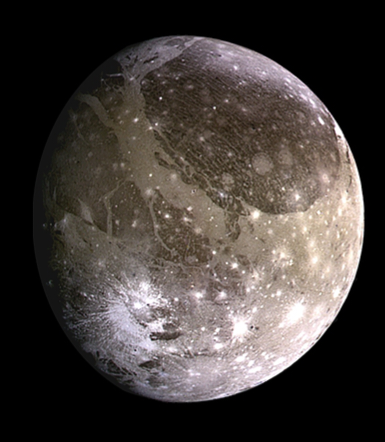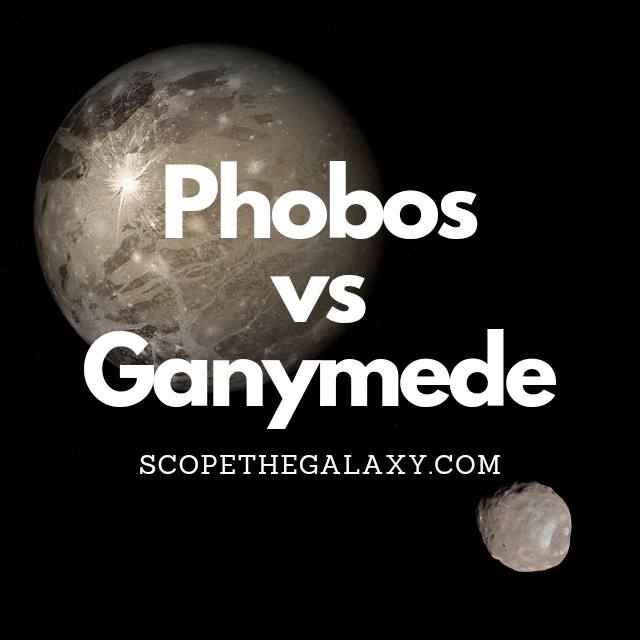*This post may contain affiliate links. This means we may make a commission if you purchase an item using one of our links*
The main differences between Phobos and Ganymede are that Ganymede is the largest moon with a diameter of 5,268km while Phobos is one of the smallest with a diameter of 22.53km, Ganymede has a magnetosphere while Phobos does not and Ganymede orbits Jupiter while Phobos orbits Mars.
There are various other differences between these to so, continue reading if you want a more thorough breakdown of their similarities and differences below.
What Is The Moon Phobos?
Table of Contents

Phobos is the larger and innermost of the Martian moons, named after the Greek God of fear and panic. This rocky satellite measures approximately 27 x 22 x 18 kilometers and possesses an irregular shape.
Flying only 270 km above Mars’s surface, Phobos orbits the Martian surface so closely that it spins around the planet three times a day (each orbit takes 7 hours and 39 minutes). And this proximity means that the moon cannot always be seen from Mars’ surface (it all depends on where you’re standing).
In general, Phobos rises in the west, passes through the sky in around 4 hours, and sets in the east. And this process occurs twice during one Martian day.
Phobos travels 1.8 m closer to Mars every 100 years, which means this doomed moon will one day crash into its planet or break up into rings. Still, this won’t happen for another 50 million years or so.
The moon is covered in streak patterns from impact craters, the most significant of which is the crater Stickney, with a diameter of 9.7 km. Phobos has weathered thousands of meteorite impacts, one of which almost shattered it to pieces.
It was first discovered by the American astronomer Asaph Hall on 17th August 1877. But, it can be difficult for astronomers to see as it is one of the least reflective bodies in the solar system with an albedo of 0.071.
Despite its small stature, Phobos experiences wildly varying temperatures on its dark side compared to the light side. Measurements on the light side of the moon suggest that temperatures can rise to -4 degrees Celsius, a sort of brisk winter’s day that would be cold but tolerable.
In contrast, temperatures on the dark side can drop to -112 degrees Celsius, even though the two areas are just a few kilometers apart. The probable cause is fine surface dust that cannot retain heat, allowing temperatures to drop rapidly.
The low density of Phobos suggests its composition is similar to carbonaceous chondrite meteorites, which could mean that Phobos is a captured asteroid.
What Is The Moon Ganymede?

Ganymede is the largest of the Galilean moons – and the largest moon in our entire solar system – first discovered on 7th January 1610. The surface of this icy world is frozen and covered by two main types of landscape: young, light regions and old, crater-filled terrain. And these darker areas seem to contain a number of organic materials.
Using the Hubble Space Telescope, astronomers have found evidence of an oxygen-based atmosphere. Still, it is far too thin to support any living organisms that we know of. Based on this, it’s unlikely that Ganymede hosts life as we know it.
Estimates place Ganymede at around 4.5 billion years old (the same age as its planet, Jupiter), and its average distance from the Sun is approximately 778 million km.
Its diameter is 5,268km, making it larger than the planet Mercury. Despite this, Ganymede only possesses half the mass of Mercury at 1.48 × 10^23kg, so it is still classified as a low-density object.
Ganymede takes seven days to orbit its planet at an average distance of 665,00km, and the temperature varies from minus 112 to minus 193 degrees Celsius. In regards to the moon’s core temperature, that would be around 1,226 – 1,446 degrees Celsius.
Among the fascinating features of this ice moon is its magnetosphere. While many planets possess a magnetosphere, no other moon in our solar system shares this trait.
Measuring the changes in the magnetic fields of Ganymede and Jupiter allowed scientists to predict that salt water lies beneath the surface of this freezing world.
However, this is insufficient to support life when you factor in the other elements of this giant moon. In contrast to Europa, the rocky layer of Ganymede is not directly below the ocean, so life would have a difficult time forming both above and below the ice.
In addition, the thick layer of ice on the moon’s surface would make internal, water-based life challenging for scientists to detect.
Similarities Between Phobos And Ganymede
As both are natural satellites, Phobos and Ganymede do share a few similarities, which includes the following:
- Both have a rocky, terrestrial surface.
- Neither have rings surrounding them.
- Both are tidally locked to their planet.
- Both orbit their planet in an elliptical pattern.
- Neither have tectonic plates.
- Ganymede and Phobos have a practically non-existent axial tilt.
Differences Between Phobos And Ganymede
As for the differences between the two so, they include the below:
- Phobos orbits Mars whilst Ganymede orbits Jupiter .
- Ganymede is a spherical shape while Phobos is not.
- Ganymede has a diameter of 5,268km whilst Phobos has a diameter of 22.53km.
- Phobos has no atmosphere whilst Ganymede has a very thin atmosphere composed of oxygen.
- Ganymede has a magnetosphere while Phobos does not.
- A day on Phobos takes 7 hours 39 minutes whilst a Ganymede day is 7 days 3 hours.
- It takes Phobos 7 hours 39 minutes to orbit Mars and around the Sun in 687 days whilst Ganymede orbits Jupiter in 7 days and 3 hours and the Sun in 12 years
- Phobos’ temperature ranges between -4 to -112 degrees Celsius whilst Ganymede’s is between -112 to -193 degree Celsius.
- Ganymede orbits Jupiter at an average distance of 665,000km whilst Phobos is 6,000km away from Mars.
- Ganymede’s density is 1.94 g/cm³ whilst Phobo’s density is 1.88 g/cm³.
- Ganymede’s mass is 1.48 × 10^23 kg whilst Phobos’ mass is 10.6 × 10^15 kg.
- Phobos’ gravitational strength is 0.0057 m/s² whilst Ganymede’s is 1.428 m/s².
- Phobos only orbits Mars 6,000km away and is getting closer to the planet by 1.8 meters every 100 years.
Summary
Despite the fact both are one of multiple moons that orbit their respective planets, Ganymede and Phobos are still significantly different in their overall stature when compared to one another.
Whether it be in regards to size, shape, their mass, magnetic field activity among other factors. Ultimately, Ganymede and Phobos are very easy to tell apart and function uniquely form one another despite both being natural satellites.

